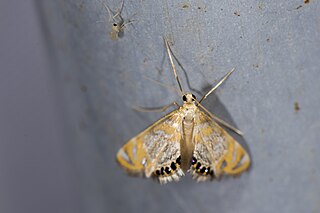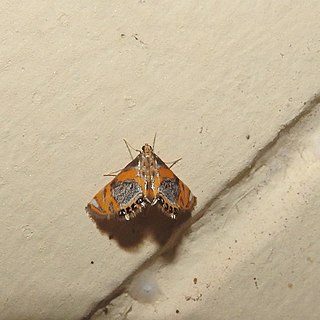
Nymphicula is a genus of moths of the family Crambidae.
Nymphicula argyrochrysalis is a moth in the family Crambidae. It was described by Paul Mabille in 1900. It is found on Madagascar.
Nymphicula cyanolitha is a moth in the family Crambidae. It was described by Edward Meyrick in 1886. It is found in Fiji.
Nymphicula nigristriata is a moth in the family Crambidae. It was described by George Hampson in 1917. It is found on New Guinea and in the Solomon Islands.
Nymphicula queenslandica is a moth in the family Crambidae. It was described by George Hampson in 1917. It is found in Australia, where it has been recorded from Queensland.
Nymphicula albibasalis is a moth in the family Crambidae. It was described by Yoshiyasu in 1980. It is found in Japan.

Nymphicula blandialis is a moth in the family Crambidae. It was described by Francis Walker in 1859. It is found in southern China, India, Malaysia, Sri Lanka, Taiwan, Japan, the Democratic Republic of the Congo, Ghana, Guinea, Mozambique, Nigeria, South Africa and Uganda.
Nymphicula mesorphna is a moth in the family Crambidae. It was described by Edward Meyrick in 1894. It is found in Myanmar, Japan and Taiwan.
Nymphicula saigusai is a moth in the family Crambidae. It was described by Yoshiyasu in 1980. It is found in Japan.

Nymphicula yoshiyasui is a moth in the family Crambidae. It was described by David John Lawrence Agassiz in 2002. It is found from Taiwan and Okinawa to Amami-Oshima in Japan.
Nymphicula beni is a moth in the family Crambidae. It was described by David John Lawrence Agassiz in 2014. It is found in Papua New Guinea.
Nymphicula cheesmanae is a moth in the family Crambidae. It was described by David John Lawrence Agassiz in 2014. It is found on the New Hebrides.
Nymphicula conjunctalis is a moth in the family Crambidae. It was described by David John Lawrence Agassiz in 2014. It is found in Australia, where it has been recorded from the Northern Territory.
Nymphicula michaeli is a moth in the family Crambidae. It was described by David John Lawrence Agassiz in 2014. It is found in Papua New Guinea.
Nymphicula monticola is a moth in the family Crambidae. It was described by David John Lawrence Agassiz in 2014. It is found in the highlands of New Guinea.
Nymphicula edwardsi is a moth in the family Crambidae. It was described by David John Lawrence Agassiz in 2014. It is found in Australia, where it has been recorded from Queensland.
Nymphicula hampsoni is a moth in the family Crambidae. It was described by David John Lawrence Agassiz in 2014. It is found in Australia, where it has been recorded from Queensland.
Nymphicula insulalis is a moth in the family Crambidae. It was described by David John Lawrence Agassiz in 2014. It is found in New Caledonia east of Australia.
Nymphicula plumbilinealis is a moth in the family Crambidae. It was described by David John Lawrence Agassiz in 2014. It is found in Papua New Guinea.
Nymphicula tariensis is a moth in the family Crambidae. It was described by David John Lawrence Agassiz in 2014. It is found in Papua New Guinea.

